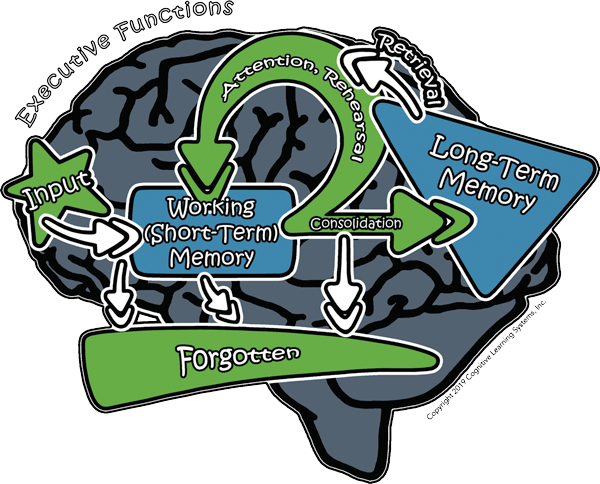Neurocognitive Perspective:
The Information Processing Model
The Information Processing Model
Information processing is important in learning and memory. In fact, if new information is not processed it will not lead to permanent new memories and learning will not occur. Conversely, the more extensively new information is processed, the better it will be remembered. The steps involved in the input and processing of new information are summarized in the Information Processing Model.
Let’s consider this model in an overview. The Input arrow indicates new information entering the brain. Most information that we are presented with never makes it through the sensory register and is lost as indicated by the downward arrow on the left (leading to “Forgotten”). We receive an enormous amount of information, thousands of stimuli per second. We can not process so much information at one time. Consider, for example, the “feel” of your right foot at this very moment. If you choose to concentrate on it, you can actually sense information being sent from your foot to your brain. Obviously, it would be difficult to concentrate on anything else if we spent all of our time dealing with information coming from our right foot, let alone the rest of our body and environment. Therefore, we routinely filter out almost all information delivered to our brain through the sensory register.
 New information that does enter the brain is available temporarily in working memory, where it may either be further processed into long-term memory or lost and forgotten (second arrow leading to “Forgotten”. In our Information Processing Model, working memory is sometimes referred to as “short-term memory”. Thus, information is not stored in working memory for very long – perhaps seconds or minutes. It is either processed further or lost forever. Not only is the storage of information in short-term memory brief, but it is also of very limited capacity. We can only place a few bits of new information into limited storage before it is filled and new information begins to replace previously-stored information – somewhat like an overflowing glass of water.
New information that does enter the brain is available temporarily in working memory, where it may either be further processed into long-term memory or lost and forgotten (second arrow leading to “Forgotten”. In our Information Processing Model, working memory is sometimes referred to as “short-term memory”. Thus, information is not stored in working memory for very long – perhaps seconds or minutes. It is either processed further or lost forever. Not only is the storage of information in short-term memory brief, but it is also of very limited capacity. We can only place a few bits of new information into limited storage before it is filled and new information begins to replace previously-stored information – somewhat like an overflowing glass of water.
The conversion of new information from working memory to long-term memory requires a process  called Consolidation. As suggested by the Information Processing Model, consolidation is a complex process involving the comparison of new information in limited storage to “previous knowledge” through Retrieval of related information from long-term memory. Thus, virtually no new information is consolidated without first comparing it to information we already have. Every bit of new information will be compared to “old” information already stored in long-term memory banks. Thus, if I tell you that in my living room I have an entertainment unit with a stereo, DVD, and television that sits just to the left of a brick fireplace, you see a version of the scene based entirely on images of entertainment units and fireplaces that you have already stored in your long-term memory. You can’t control this – all new information is encountered in terms of previous knowledge.
called Consolidation. As suggested by the Information Processing Model, consolidation is a complex process involving the comparison of new information in limited storage to “previous knowledge” through Retrieval of related information from long-term memory. Thus, virtually no new information is consolidated without first comparing it to information we already have. Every bit of new information will be compared to “old” information already stored in long-term memory banks. Thus, if I tell you that in my living room I have an entertainment unit with a stereo, DVD, and television that sits just to the left of a brick fireplace, you see a version of the scene based entirely on images of entertainment units and fireplaces that you have already stored in your long-term memory. You can’t control this – all new information is encountered in terms of previous knowledge.
Subsequent rehearsal of the new information in the context of what is already known, may then lead, through consolidation, to its permanent storage in long-term memory. Rehearsal comes in many forms in the classroom environment. Homework problems that necessitate the application of information gained in class are rehearsal. One student explaining new information to another is rehearsal for both students. Students working on their lab analysis/discussion based on data they collected while conducting an experiment is rehearsal – and so on. Actually, almost any time you refer back to newly introduced information and use it in any way, it is a rehearsal of one form or another, and will help you consolidate it into your long-term memory – that is, you learn it!
By far, most information in working memory never makes it to long-term memory – it is not consolidated – it is lost and forgotten (the third arrow in the model leading to “Forgotten”). For information to enter and remain in long-term memory, new connections between the nerve cells (neurons) must be made. This is a physical change that involves turning on genes and making proteins. Thus, learning is a physiological process that can be affected by nutrition, drugs, sleep, and other factors that impact the overall status of the body.
 Executive Functions play various and controlling roles in the overall process of information processing. Executive functions essentially oversees the handling of new information – it orchestrates and controls retrieval of relevant pre-existing information from long-term memory, it guides rehearsal, it helps direct attention. It is responsible for the integration of different brain functions. When you decide that a new piece of information is similar to something that you have seen before, that is an example of using your executive functions. When you realize that you did not understand a concept that you just read and decide to reread the paragraph containing it, you are using executive functions both to check your understanding of the concept and to formulate a plan (rereading the paragraph) for improving your understanding.
Executive Functions play various and controlling roles in the overall process of information processing. Executive functions essentially oversees the handling of new information – it orchestrates and controls retrieval of relevant pre-existing information from long-term memory, it guides rehearsal, it helps direct attention. It is responsible for the integration of different brain functions. When you decide that a new piece of information is similar to something that you have seen before, that is an example of using your executive functions. When you realize that you did not understand a concept that you just read and decide to reread the paragraph containing it, you are using executive functions both to check your understanding of the concept and to formulate a plan (rereading the paragraph) for improving your understanding.
As the Information Processing Model suggests, Attention is required throughout information processing. No new information can be consolidated into long-term memory if we do not attend to it. Executive functions are involved in helping you decide what you should focus your attention on in a given circumstance. Thus, executive functions oversees and guides almost all areas of information processing and learning.

